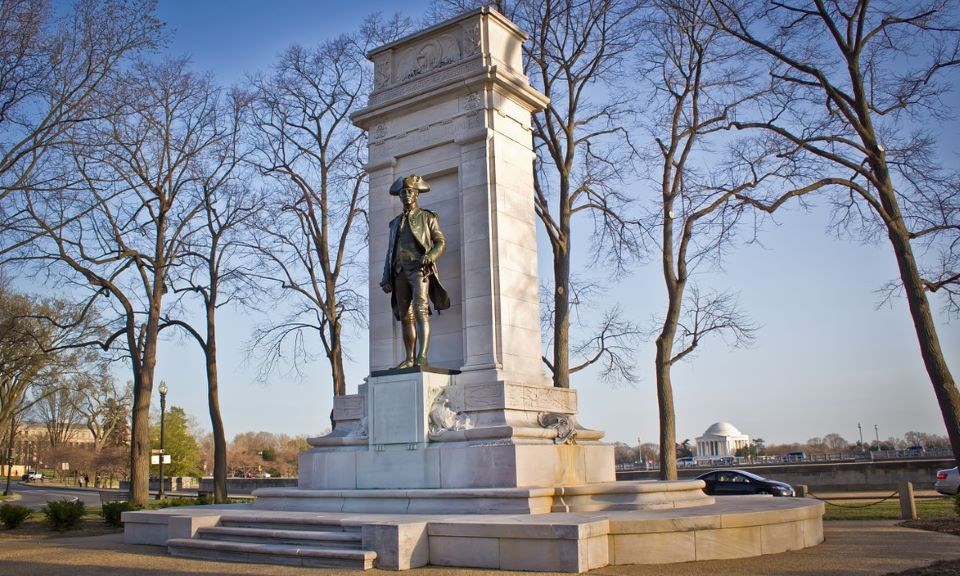
At the intersection of 17th Street and Independence Avenue SW stands an overlooked statue of John Paul Jones, the most recognized naval hero of the American Revolution. Some also regard Jones as the father of the United States Navy. John Paul Jones was born simply John Paul in the Scottish village of Kirkcudbrightshire in 1747 and went to work at sea at the tender age of 13. In 1774, as a young merchant ship captain, John Paul moved to Virginia and added the Jones to his name. When the American Revolution began, he was quickly recruited as one of our first naval officers. He quickly rose to command: first of the sloop Providence, then the brig Ranger and eventually the great ship Bonhomme Richard. The Bonhomme Richard was a former French merchant ship donated and rearmed for the US Navy. Jones would name the ship for his patron, Benjamin Franklin. Jones won his greatest victory on September 23, 1779 off Flamborough Head in Northeastern England. A Franco-American squadron commanded by Jones attacked a British convoy. During the battle, the Bonhomme Richard became locked in combat with a superior British frigate the HMS Serapis. At first, the Americans bore the brunt of the fighting with the Bonhomme Richard catching fire and flooding the bottom five feet of its hold. Convinced of an impending victory, the British Captain Richard Pearson called on Jones to surrender. Jones reportedly replied, “Surrender? I have not yet begun to fight!” Two hours into the duel, the ships became entangled. Jones would win the battle with fighting at close quarters. After a valiant resistance the HMS Serapis surrendered. Jones would transfer his flag and his crew to the Serapis, after the battle, when the Bonhomme Richard sank from its battle damage. Afterwards Jones was recalled to the United States to take command of the young nation’s first sailing battleship the USS America. Before he could return to the fight the war ended and the Navy was disbanded. Jones would go on to a colorful postwar career that included a stint as an admiral in the Imperial Russian Navy. Tragically, John Paul Jones would die of illness in Paris in 1792 at the age of 45. He was interred at the Paris Saint Louis Cemetery for Foreign Protestants. The French, anticipating the US government would one day wish to return Jones’s remains to America, buried him in an expensive lead casket that was filled with rum for preservation. In 1905, after an extensive four-year search funded by the US Ambassador Horace Porter, Jones’s body was rediscovered. President Theodore Roosevelt would have Captain John Paul Jones reinterred at a specially built chapel at the US Naval Academy in Annapolis, Maryland. Renewed interest in John Paul Jones led to Congress allocating $50,000 in June 1909 for a memorial to be built for him on the National Mall. The memorial includes a bronze statue of Jones, 10 feet high, sculpted by Charles Henry Niehaus of New York City. It shows Jones standing with his left hand on the hilt of his sword. The rest of the memorial has a 15-foot marble pylon behind him, with two bronze dolphins on either side shooting water. This part was designed by the firm of Carrere & Hasting also of New York City. The John Paul Jones Memorial was dedicated on April 17, 1912 which, by happenstance, was just two days after the British steamship Titanic sank. The memorial was dedicated by President William Howard Taft. The statue was unveiled by Spanish American War hero Admiral George Dewey. Jones is also remembered by his adversaries. The quaint Scottish cottage on the estate of Arbigland, where the gardener’s son, the future John Paul Jones, grew up has been preserved as a museum. Furthermore, the British Port of Whitehaven, raided by Captain Jones during the American Revolution, decided to pardon him in 1999. |
Last updated: July 5, 2023
